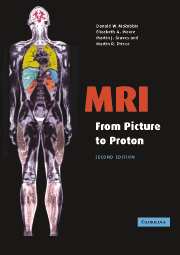Book contents
- Frontmatter
- Contents
- Acknowledgements
- 1 MR: What's the attraction?
- Part A The basic stuff
- 2 Early daze: your first week in MR
- 3 Seeing is believing: introduction to image contrast
- 4 The devil's in the detail: pixels, matrices and slices
- 5 What you set is what you get: basic image optimization
- 6 Improving your image: how to avoid artifacts
- 7 Spaced out: spatial encoding
- 8 Getting in tune: resonance and relaxation
- 9 Let's talk technical: MR equipment
- 10 But is it safe? Bio-effects
- Part B The specialist stuff
- Appendix: maths revision
- Index
- Plate section
4 - The devil's in the detail: pixels, matrices and slices
Published online by Cambridge University Press: 08 October 2009
- Frontmatter
- Contents
- Acknowledgements
- 1 MR: What's the attraction?
- Part A The basic stuff
- 2 Early daze: your first week in MR
- 3 Seeing is believing: introduction to image contrast
- 4 The devil's in the detail: pixels, matrices and slices
- 5 What you set is what you get: basic image optimization
- 6 Improving your image: how to avoid artifacts
- 7 Spaced out: spatial encoding
- 8 Getting in tune: resonance and relaxation
- 9 Let's talk technical: MR equipment
- 10 But is it safe? Bio-effects
- Part B The specialist stuff
- Appendix: maths revision
- Index
- Plate section
Summary
Introduction
MR images are not like photographs or plain X-radiographs; they are made up of thousands of tiny squares known as pixels (a contraction of ‘picture elements’) or voxels (‘volume elements’). CT images are also made up of pixels, as are digital subtraction angiograms (DSA). The common link between MR, CT and DSA is that all these images are acquired digitally, by a computer, whereas plain X-radiographs or ordinary photographs are analogue processes.
Digital data have many advantages – they can be easily manipulated by computers, stored in a very small physical space and reproduced many times – but they also require some special understanding. In this chapter we show:
that the analogue MR signal is digitized in order to create the image, and data can be misrepresented due to the digitization process;
the organization of the image as pixels in a matrix with phase and frequency encoding directions;
the relationship between the image matrix and the physical field of view, and how each pixel represents the MR signal from a small volume of tissue;
the size of the voxel can be calculated from the FOV and matrix, which defines the resolution in MR images;
that MR images can be acquired as either multi-slice two-dimensional scans, or as a three-dimensional volume, each of which has advantages and disadvantages.
Information
- Type
- Chapter
- Information
- MRI from Picture to Proton , pp. 47 - 64Publisher: Cambridge University PressPrint publication year: 2006
